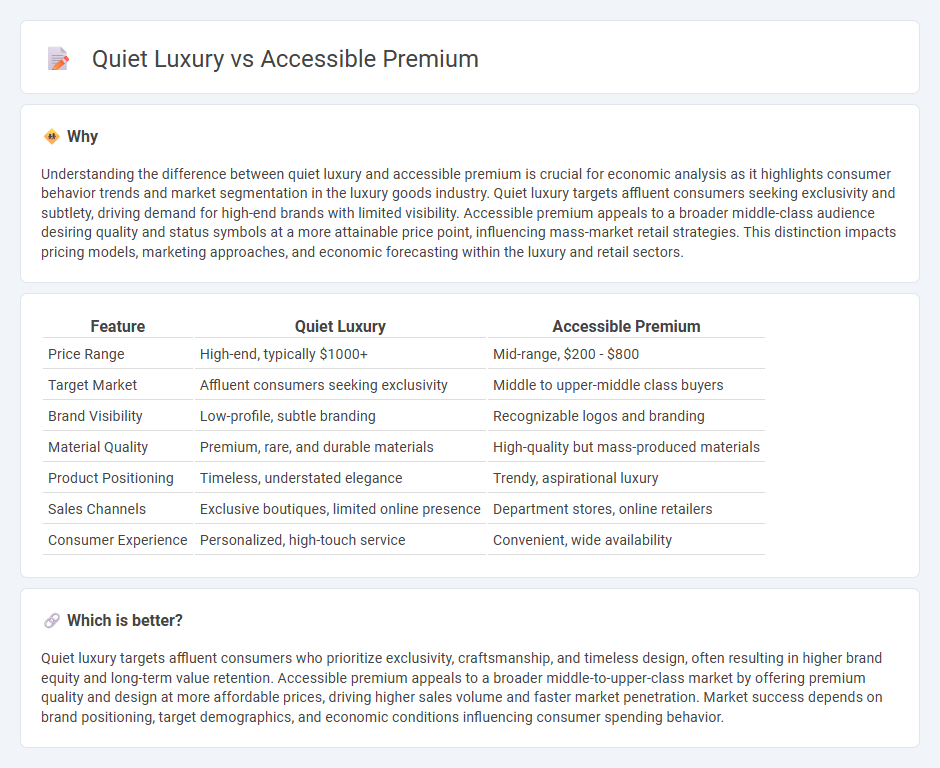
Quiet luxury emphasizes understated elegance, focusing on high-quality materials and craftsmanship without overt branding, appealing to discerning consumers seeking exclusivity. Accessible premium offers a balance between luxury and affordability, targeting a broader market with products that provide perceived value and aspirational status. Explore how these contrasting strategies shape consumer behavior and market dynamics in the evolving economy.
Why it is important
Understanding the difference between quiet luxury and accessible premium is crucial for economic analysis as it highlights consumer behavior trends and market segmentation in the luxury goods industry. Quiet luxury targets affluent consumers seeking exclusivity and subtlety, driving demand for high-end brands with limited visibility. Accessible premium appeals to a broader middle-class audience desiring quality and status symbols at a more attainable price point, influencing mass-market retail strategies. This distinction impacts pricing models, marketing approaches, and economic forecasting within the luxury and retail sectors.
Comparison Table
| Feature | Quiet Luxury | Accessible Premium |
|---|---|---|
| Price Range | High-end, typically $1000+ | Mid-range, $200 - $800 |
| Target Market | Affluent consumers seeking exclusivity | Middle to upper-middle class buyers |
| Brand Visibility | Low-profile, subtle branding | Recognizable logos and branding |
| Material Quality | Premium, rare, and durable materials | High-quality but mass-produced materials |
| Product Positioning | Timeless, understated elegance | Trendy, aspirational luxury |
| Sales Channels | Exclusive boutiques, limited online presence | Department stores, online retailers |
| Consumer Experience | Personalized, high-touch service | Convenient, wide availability |
Which is better?
Quiet luxury targets affluent consumers who prioritize exclusivity, craftsmanship, and timeless design, often resulting in higher brand equity and long-term value retention. Accessible premium appeals to a broader middle-to-upper-class market by offering premium quality and design at more affordable prices, driving higher sales volume and faster market penetration. Market success depends on brand positioning, target demographics, and economic conditions influencing consumer spending behavior.
Connection
Quiet luxury and accessible premium intersect through consumer demand for understated quality combined with affordability, influencing market trends toward refined yet attainable products. Brands strategically balance exclusivity and accessibility by offering minimalist designs and superior craftsmanship without excessive pricing. This connection drives growth in the premium economy segment, appealing to discerning customers seeking value and sophistication.
Key Terms
Pricing Strategy
Accessible premium brands utilize competitive pricing strategies, balancing affordability with higher quality to attract middle-class consumers seeking luxury experiences without the elite price tag. Quiet luxury, in contrast, employs a scarcity-driven pricing model, emphasizing exclusivity and subtle branding, often targeting affluent customers willing to pay a premium for understated elegance. Explore the nuances of these pricing strategies to better understand consumer perception and market positioning.
Consumer Segmentation
Accessible premium targets aspirational consumers seeking high-quality, stylish products at attainable price points, blending affordability with status appeal. Quiet luxury appeals to affluent, discerning customers who prioritize exclusivity, craftsmanship, and understated elegance over conspicuous branding. Explore deeper insights into consumer segmentation to tailor marketing strategies effectively.
Brand Positioning
Accessible premium brands position themselves by offering high-quality products at relatively affordable prices, appealing to a broader demographic seeking luxury without exclusivity. Quiet luxury emphasizes understated elegance, exclusivity, and craftsmanship, targeting affluent consumers who value subtlety over conspicuous branding. Explore our in-depth analysis to understand how these distinct brand positioning strategies impact consumer perception and market dynamics.
Source and External Links
Accessible Premium 2 Queens with River View - Driftwood Lodge - A comfortable accessible premium hotel room featuring two queen beds, river views, closed captioning, audible emergency alarms, accessible baths, and service dog allowance, designed for ease and comfort in Springdale, Utah.
Accessible Premium Garden View (ADA) - Kauai Beach Resort Hotel - ADA compliant accessible premium room with island decor, private lanai, mountain garden views, accessible bathroom and doors, high-speed internet, and daily maid service at a resort in Kauai.
Accessible Premium Studio - The Marlin Hotel - A detailed studio featuring premium accessibility, including accessible bathroom access, spa products, Nespresso machine, king size bed, high-speed internet, and modern entertainment options.
 dowidth.com
dowidth.com